Small Business Management Report: Analysis of Coca-Cola's Concepts
VerifiedAdded on 2023/06/07
|5
|1114
|57
Report
AI Summary
This report provides an overview of Coca-Cola's business concepts, focusing on its strategies within the soft drink industry. It identifies the company's primary target customers (ages 12-30) and loyal brand consumers, while also acknowledging PepsiCo and Red Bull as major competitors. The report details Coca-Cola's diverse product range, pricing strategies relative to competitors, and its divisional organizational structure. Promotional strategies, including attractive packaging, memorable taglines, and corporate sustainability activities, are also examined. The analysis concludes that Coca-Cola's success stems from its comprehensive strategies and effective targeting of the right customers. Desklib offers this report as a resource for students, along with a wealth of other solved assignments and past papers.
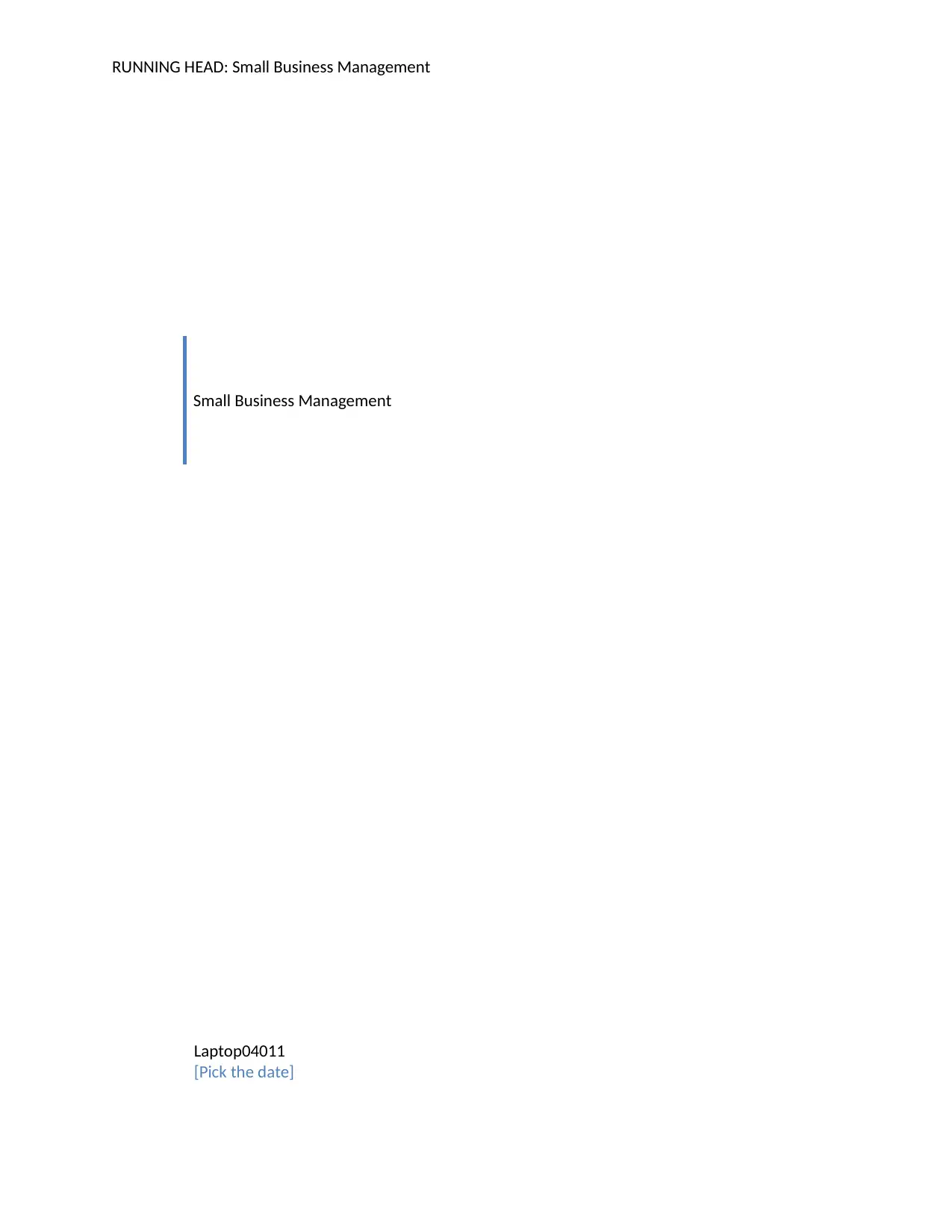
RUNNING HEAD: Small Business Management
Small Business Management
Laptop04011
[Pick the date]
Small Business Management
Laptop04011
[Pick the date]
Paraphrase This Document
Need a fresh take? Get an instant paraphrase of this document with our AI Paraphraser
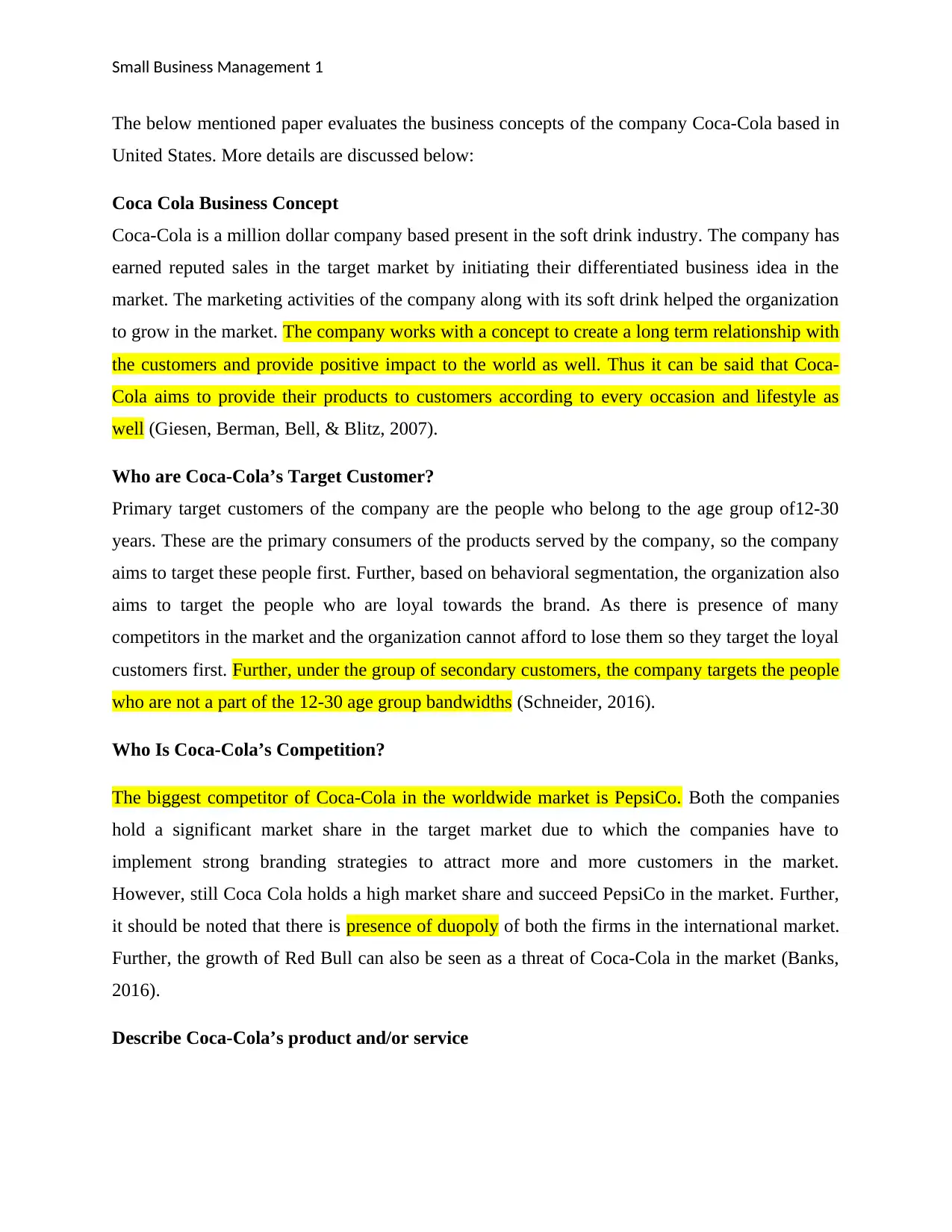
Small Business Management 1
The below mentioned paper evaluates the business concepts of the company Coca-Cola based in
United States. More details are discussed below:
Coca Cola Business Concept
Coca-Cola is a million dollar company based present in the soft drink industry. The company has
earned reputed sales in the target market by initiating their differentiated business idea in the
market. The marketing activities of the company along with its soft drink helped the organization
to grow in the market. The company works with a concept to create a long term relationship with
the customers and provide positive impact to the world as well. Thus it can be said that Coca-
Cola aims to provide their products to customers according to every occasion and lifestyle as
well (Giesen, Berman, Bell, & Blitz, 2007).
Who are Coca-Cola’s Target Customer?
Primary target customers of the company are the people who belong to the age group of12-30
years. These are the primary consumers of the products served by the company, so the company
aims to target these people first. Further, based on behavioral segmentation, the organization also
aims to target the people who are loyal towards the brand. As there is presence of many
competitors in the market and the organization cannot afford to lose them so they target the loyal
customers first. Further, under the group of secondary customers, the company targets the people
who are not a part of the 12-30 age group bandwidths (Schneider, 2016).
Who Is Coca-Cola’s Competition?
The biggest competitor of Coca-Cola in the worldwide market is PepsiCo. Both the companies
hold a significant market share in the target market due to which the companies have to
implement strong branding strategies to attract more and more customers in the market.
However, still Coca Cola holds a high market share and succeed PepsiCo in the market. Further,
it should be noted that there is presence of duopoly of both the firms in the international market.
Further, the growth of Red Bull can also be seen as a threat of Coca-Cola in the market (Banks,
2016).
Describe Coca-Cola’s product and/or service
The below mentioned paper evaluates the business concepts of the company Coca-Cola based in
United States. More details are discussed below:
Coca Cola Business Concept
Coca-Cola is a million dollar company based present in the soft drink industry. The company has
earned reputed sales in the target market by initiating their differentiated business idea in the
market. The marketing activities of the company along with its soft drink helped the organization
to grow in the market. The company works with a concept to create a long term relationship with
the customers and provide positive impact to the world as well. Thus it can be said that Coca-
Cola aims to provide their products to customers according to every occasion and lifestyle as
well (Giesen, Berman, Bell, & Blitz, 2007).
Who are Coca-Cola’s Target Customer?
Primary target customers of the company are the people who belong to the age group of12-30
years. These are the primary consumers of the products served by the company, so the company
aims to target these people first. Further, based on behavioral segmentation, the organization also
aims to target the people who are loyal towards the brand. As there is presence of many
competitors in the market and the organization cannot afford to lose them so they target the loyal
customers first. Further, under the group of secondary customers, the company targets the people
who are not a part of the 12-30 age group bandwidths (Schneider, 2016).
Who Is Coca-Cola’s Competition?
The biggest competitor of Coca-Cola in the worldwide market is PepsiCo. Both the companies
hold a significant market share in the target market due to which the companies have to
implement strong branding strategies to attract more and more customers in the market.
However, still Coca Cola holds a high market share and succeed PepsiCo in the market. Further,
it should be noted that there is presence of duopoly of both the firms in the international market.
Further, the growth of Red Bull can also be seen as a threat of Coca-Cola in the market (Banks,
2016).
Describe Coca-Cola’s product and/or service
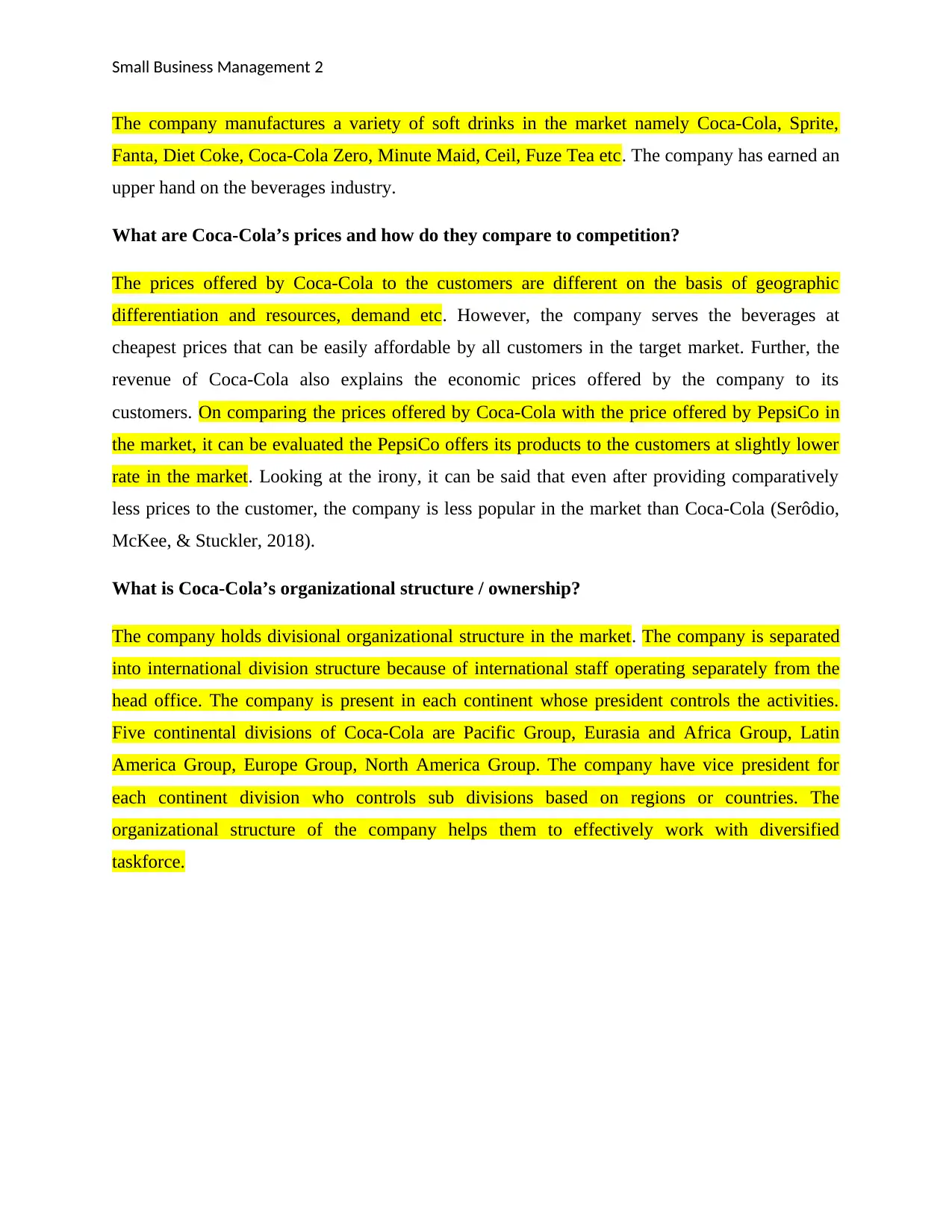
Small Business Management 2
The company manufactures a variety of soft drinks in the market namely Coca-Cola, Sprite,
Fanta, Diet Coke, Coca-Cola Zero, Minute Maid, Ceil, Fuze Tea etc. The company has earned an
upper hand on the beverages industry.
What are Coca-Cola’s prices and how do they compare to competition?
The prices offered by Coca-Cola to the customers are different on the basis of geographic
differentiation and resources, demand etc. However, the company serves the beverages at
cheapest prices that can be easily affordable by all customers in the target market. Further, the
revenue of Coca-Cola also explains the economic prices offered by the company to its
customers. On comparing the prices offered by Coca-Cola with the price offered by PepsiCo in
the market, it can be evaluated the PepsiCo offers its products to the customers at slightly lower
rate in the market. Looking at the irony, it can be said that even after providing comparatively
less prices to the customer, the company is less popular in the market than Coca-Cola (Serôdio,
McKee, & Stuckler, 2018).
What is Coca-Cola’s organizational structure / ownership?
The company holds divisional organizational structure in the market. The company is separated
into international division structure because of international staff operating separately from the
head office. The company is present in each continent whose president controls the activities.
Five continental divisions of Coca-Cola are Pacific Group, Eurasia and Africa Group, Latin
America Group, Europe Group, North America Group. The company have vice president for
each continent division who controls sub divisions based on regions or countries. The
organizational structure of the company helps them to effectively work with diversified
taskforce.
The company manufactures a variety of soft drinks in the market namely Coca-Cola, Sprite,
Fanta, Diet Coke, Coca-Cola Zero, Minute Maid, Ceil, Fuze Tea etc. The company has earned an
upper hand on the beverages industry.
What are Coca-Cola’s prices and how do they compare to competition?
The prices offered by Coca-Cola to the customers are different on the basis of geographic
differentiation and resources, demand etc. However, the company serves the beverages at
cheapest prices that can be easily affordable by all customers in the target market. Further, the
revenue of Coca-Cola also explains the economic prices offered by the company to its
customers. On comparing the prices offered by Coca-Cola with the price offered by PepsiCo in
the market, it can be evaluated the PepsiCo offers its products to the customers at slightly lower
rate in the market. Looking at the irony, it can be said that even after providing comparatively
less prices to the customer, the company is less popular in the market than Coca-Cola (Serôdio,
McKee, & Stuckler, 2018).
What is Coca-Cola’s organizational structure / ownership?
The company holds divisional organizational structure in the market. The company is separated
into international division structure because of international staff operating separately from the
head office. The company is present in each continent whose president controls the activities.
Five continental divisions of Coca-Cola are Pacific Group, Eurasia and Africa Group, Latin
America Group, Europe Group, North America Group. The company have vice president for
each continent division who controls sub divisions based on regions or countries. The
organizational structure of the company helps them to effectively work with diversified
taskforce.
⊘ This is a preview!⊘
Do you want full access?
Subscribe today to unlock all pages.

Trusted by 1+ million students worldwide
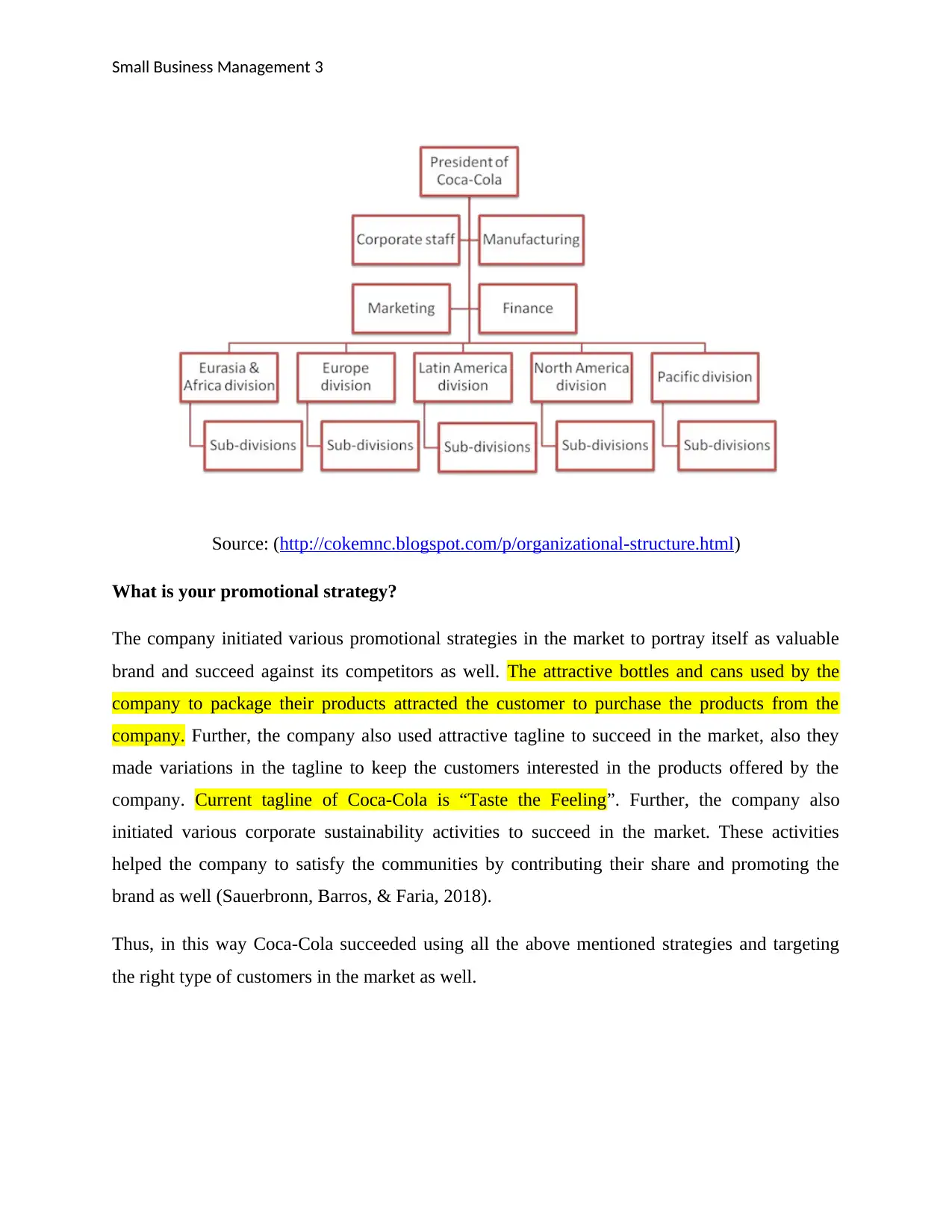
Small Business Management 3
Source: (http://cokemnc.blogspot.com/p/organizational-structure.html)
What is your promotional strategy?
The company initiated various promotional strategies in the market to portray itself as valuable
brand and succeed against its competitors as well. The attractive bottles and cans used by the
company to package their products attracted the customer to purchase the products from the
company. Further, the company also used attractive tagline to succeed in the market, also they
made variations in the tagline to keep the customers interested in the products offered by the
company. Current tagline of Coca-Cola is “Taste the Feeling”. Further, the company also
initiated various corporate sustainability activities to succeed in the market. These activities
helped the company to satisfy the communities by contributing their share and promoting the
brand as well (Sauerbronn, Barros, & Faria, 2018).
Thus, in this way Coca-Cola succeeded using all the above mentioned strategies and targeting
the right type of customers in the market as well.
Source: (http://cokemnc.blogspot.com/p/organizational-structure.html)
What is your promotional strategy?
The company initiated various promotional strategies in the market to portray itself as valuable
brand and succeed against its competitors as well. The attractive bottles and cans used by the
company to package their products attracted the customer to purchase the products from the
company. Further, the company also used attractive tagline to succeed in the market, also they
made variations in the tagline to keep the customers interested in the products offered by the
company. Current tagline of Coca-Cola is “Taste the Feeling”. Further, the company also
initiated various corporate sustainability activities to succeed in the market. These activities
helped the company to satisfy the communities by contributing their share and promoting the
brand as well (Sauerbronn, Barros, & Faria, 2018).
Thus, in this way Coca-Cola succeeded using all the above mentioned strategies and targeting
the right type of customers in the market as well.
Paraphrase This Document
Need a fresh take? Get an instant paraphrase of this document with our AI Paraphraser
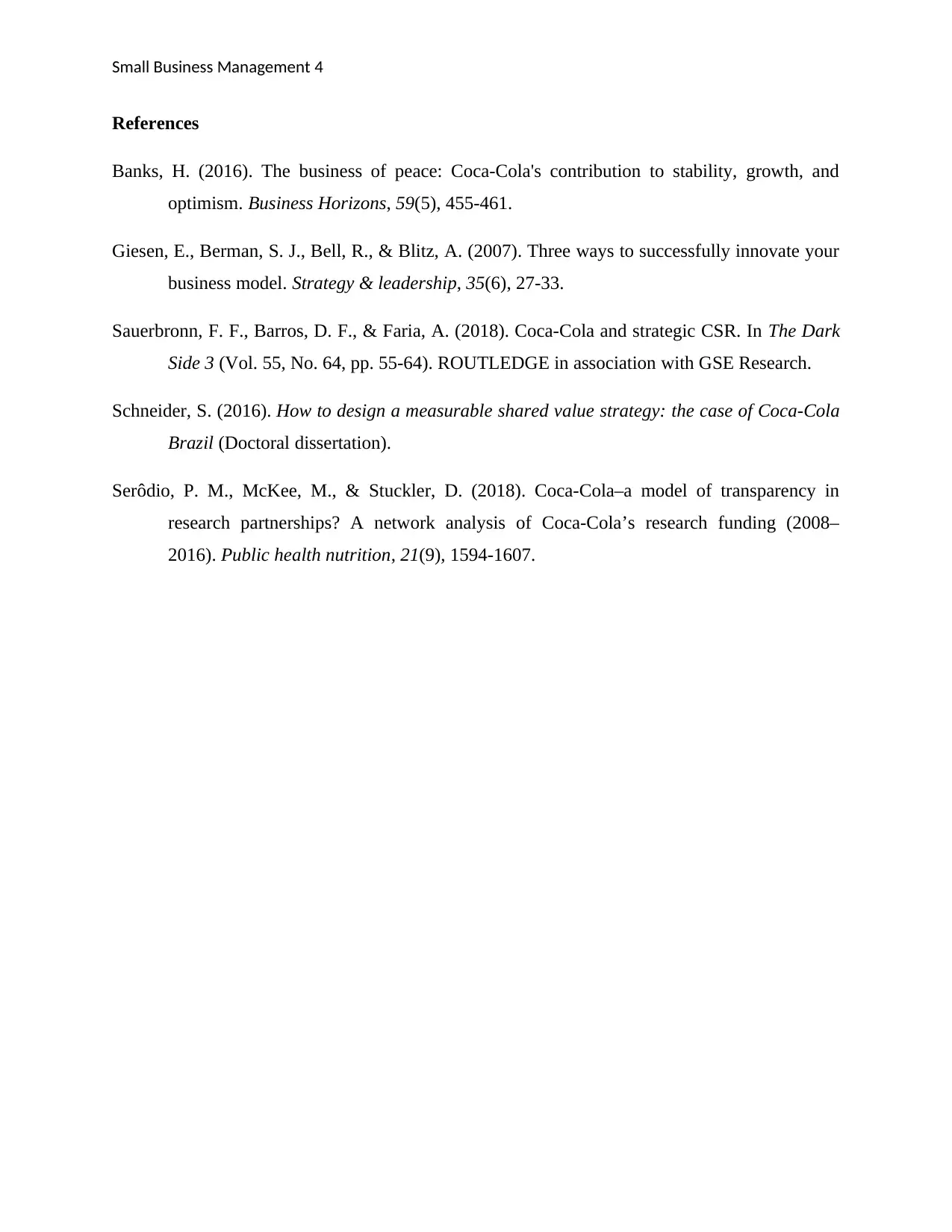
Small Business Management 4
References
Banks, H. (2016). The business of peace: Coca-Cola's contribution to stability, growth, and
optimism. Business Horizons, 59(5), 455-461.
Giesen, E., Berman, S. J., Bell, R., & Blitz, A. (2007). Three ways to successfully innovate your
business model. Strategy & leadership, 35(6), 27-33.
Sauerbronn, F. F., Barros, D. F., & Faria, A. (2018). Coca-Cola and strategic CSR. In The Dark
Side 3 (Vol. 55, No. 64, pp. 55-64). ROUTLEDGE in association with GSE Research.
Schneider, S. (2016). How to design a measurable shared value strategy: the case of Coca-Cola
Brazil (Doctoral dissertation).
Serôdio, P. M., McKee, M., & Stuckler, D. (2018). Coca-Cola–a model of transparency in
research partnerships? A network analysis of Coca-Cola’s research funding (2008–
2016). Public health nutrition, 21(9), 1594-1607.
References
Banks, H. (2016). The business of peace: Coca-Cola's contribution to stability, growth, and
optimism. Business Horizons, 59(5), 455-461.
Giesen, E., Berman, S. J., Bell, R., & Blitz, A. (2007). Three ways to successfully innovate your
business model. Strategy & leadership, 35(6), 27-33.
Sauerbronn, F. F., Barros, D. F., & Faria, A. (2018). Coca-Cola and strategic CSR. In The Dark
Side 3 (Vol. 55, No. 64, pp. 55-64). ROUTLEDGE in association with GSE Research.
Schneider, S. (2016). How to design a measurable shared value strategy: the case of Coca-Cola
Brazil (Doctoral dissertation).
Serôdio, P. M., McKee, M., & Stuckler, D. (2018). Coca-Cola–a model of transparency in
research partnerships? A network analysis of Coca-Cola’s research funding (2008–
2016). Public health nutrition, 21(9), 1594-1607.
1 out of 5
Related Documents
Your All-in-One AI-Powered Toolkit for Academic Success.
+13062052269
info@desklib.com
Available 24*7 on WhatsApp / Email
![[object Object]](/_next/static/media/star-bottom.7253800d.svg)
Unlock your academic potential
Copyright © 2020–2025 A2Z Services. All Rights Reserved. Developed and managed by ZUCOL.




